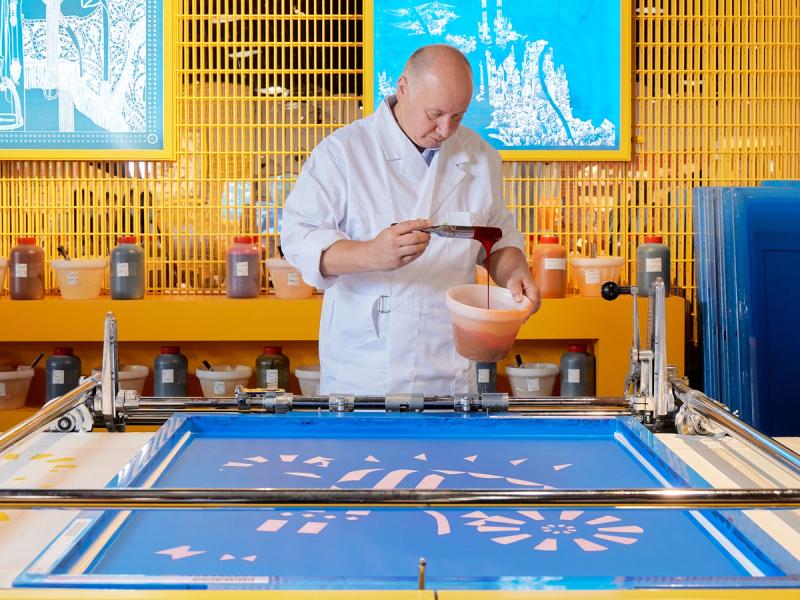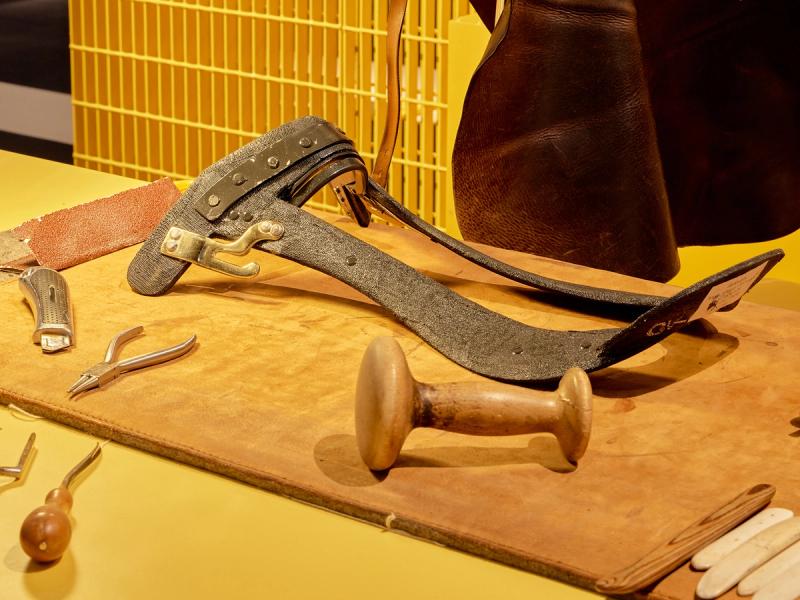
In Detroit, a Six-Day Hermès Exhibition Celebrates Craft and Community
Detroit is a city of craft. Of carmakers and Carhartt. Of Motown Records and Eminem. Of iconic midcentury design (Isamu Noguchi’s Hart Plaza and Dodge Fountain, buildings by Mies van der Rohe and Minoru Yamasaki). Of the Cranbrook Academy of Art (in nearby Bloomfield Hills), the Detroit Institute of Arts, and the Heidelberg Project. So it’s fitting that, following previous iterations in Copenhagen, last fall, and in Turin, Italy, last month, the French luxury house Hermès has headed here—to the suburb of Troy, specifically, where it also recently opened a store—to present its latest “Hermès in the Making” exhibition (through June 15). A playful, Willy Wonka factory–like presentation of the company’s know-how, the display offers “an opportunity to peek behind the curtain,” as Kamel Hamadou, one of the company’s expert silk scarf-makers, cheekily puts it. Poppy and pompy, it is a verifiable high-craft wonderland and a joy to behold. One would be hard-pressed not to smile while walking through it.
Divided into four sections—”A Culture of Traditional Craftsmanship,” “High-Quality Materials,” “The Talent of Our Regions,” and “Time, Our Ally”—the exhibition functions as a crash course on the Paris-based company, founded in 1837, and its 52 workshops and production sites across France (which employ nearly 6,000 craftspeople). At the “Printing the Silk” display, Hamadou guides viewers through the mesmerizing, nearly hour-long, step-by-step process of silk-screen printing, using a flatbed-screen technique that requires three years of training under a tutor to master. “It’s like cooking a family recipe,” Hamadou says of making an Hermès scarf. “A secret!” Beyond, stations feature artisans in saddle-stitching, porcelain painting, gemstone setting, glove-making, leather working, watchmaking, and leather repair. Throughout, various gadgets, gizmos, and displays delight, from phones featuring “after-sales anecdotes,” to leather odor diffusers, to a circa-1990 Volvo steering wheel covered in calf leather, to a Mars meteorite fragment found in North Africa (and used in the Hermès Arceau L’Heure De La Lune watch dial).

Upon entering, visitors can explore the exhibition any which way, but the most logical direction, fittingly, is clockwise. In a way, the whole experience is a sort of time-based performance, one in which the company’s clockwork, both literal and figurative, is on full display. A celebration of not only craft, but craftspeople, “Hermès in the Making” emphasizes the ticking heartbeat of Hermès: its artisans.
As much as it focuses on time-honored traditions, the exhibition also looks forward. One wall text highlights the company’s vast impacts on the regional communities it supports in France, where roughly half of the new jobs it creates globally each year are based, and where an “overwhelming majority” of its objects are produced. A nearby architectural model presents one of Hermès’s next major expansion efforts: a squat, elegantly arched, square-shaped brick building, designed by the Franco-Lebanese architect Lina Ghotmeh, that will be home to the company’s 22nd (yes, 22nd) leather-goods workshop when it opens in the Normandy town of Louviers later this year.

“Hermès in the Making” is no simple marketing exercise. As with the house’s wares, it is an intricate and multilayered affair. Not only is the exhibition entertaining and educational, it espouses a fewer-better-things, craft-is-vital gospel, the sort that’s needed now—in the face of the climate crisis and today’s fast-fashion age of the cheap and disposable—more than ever.
A high-concept form of brand awareness, the project is also a community-engagement effort. In addition to partnerships with Detroit’s College for Creative Studies and the international nonprofit Nest—whose executive director, Rebecca van Bergen, is leading conversations on regeneration and repair as part of the programming and launching, with support from Hermès, a program for Detroit-based makers—the company has also connected with the Detroit Achievement Academy (DAA), a nonprofit charter school started in 2013, where children are taught a three-pronged, craft-forward education around “mastery of knowledge and skills,” “habits of character,” and “high-quality work.” With DAA, Hermès has donated upcycled silk “wings” for its students to create D.I.Y. birdsavers (used to prevent bird deaths by window); students from DAA are also visiting the exhibition, where they’ll learn about sustainability and craftsmanship firsthand. Kyle Smitley, DAA’s founder and executive director, describes the Hermès partnership as “transformational” and “one of mutual respect and alignment.” Noting a “complete overlap” between DAA’s values and Hermès’s, she adds that the project has “lit a fire” in DAA’s students. It’s a fire that, hopefully, will arrive in more American cities in the future. At least one more U.S. “Hermès in the Making” experience is on the horizon: In October, the artisans will arrive in Austin.